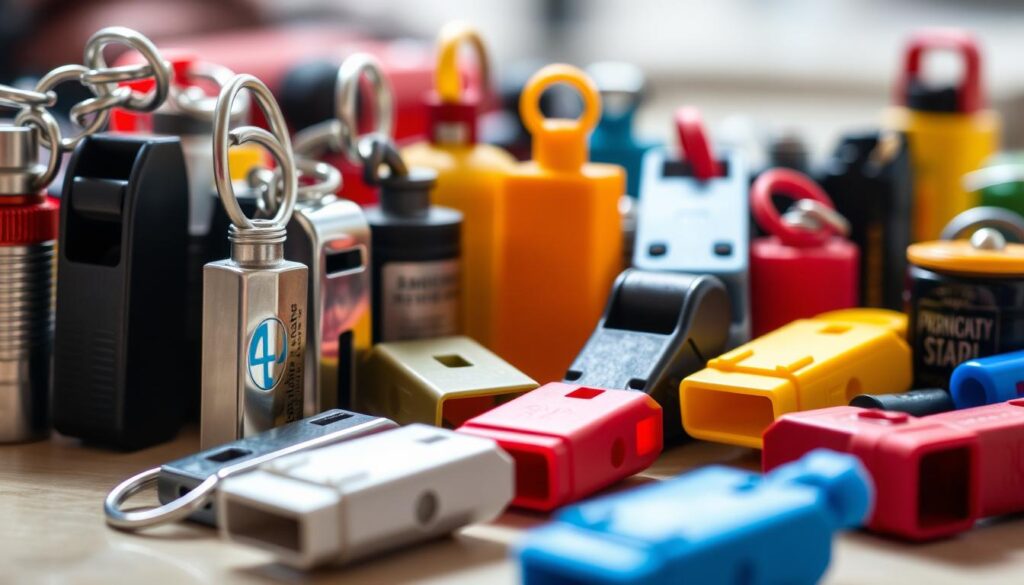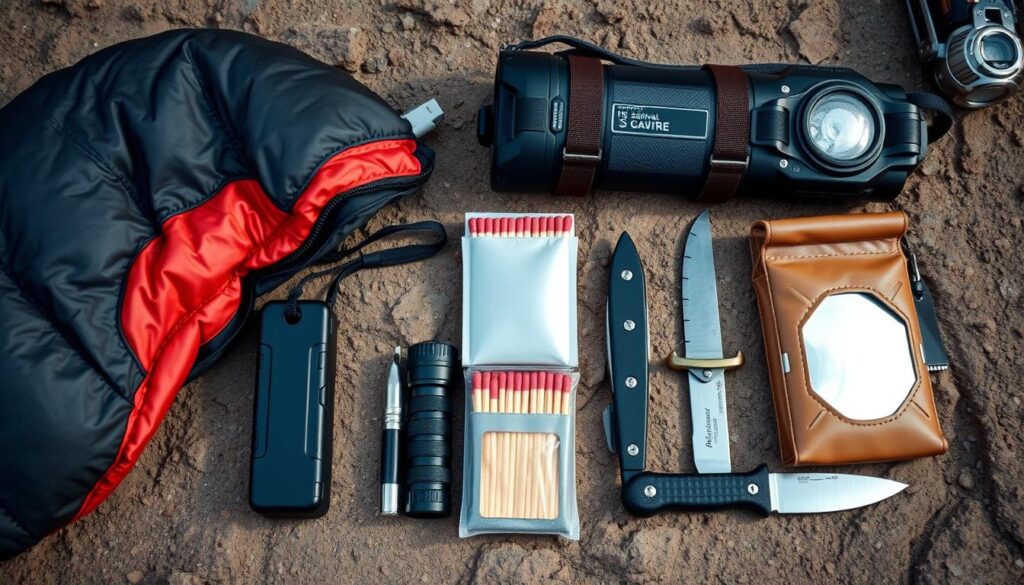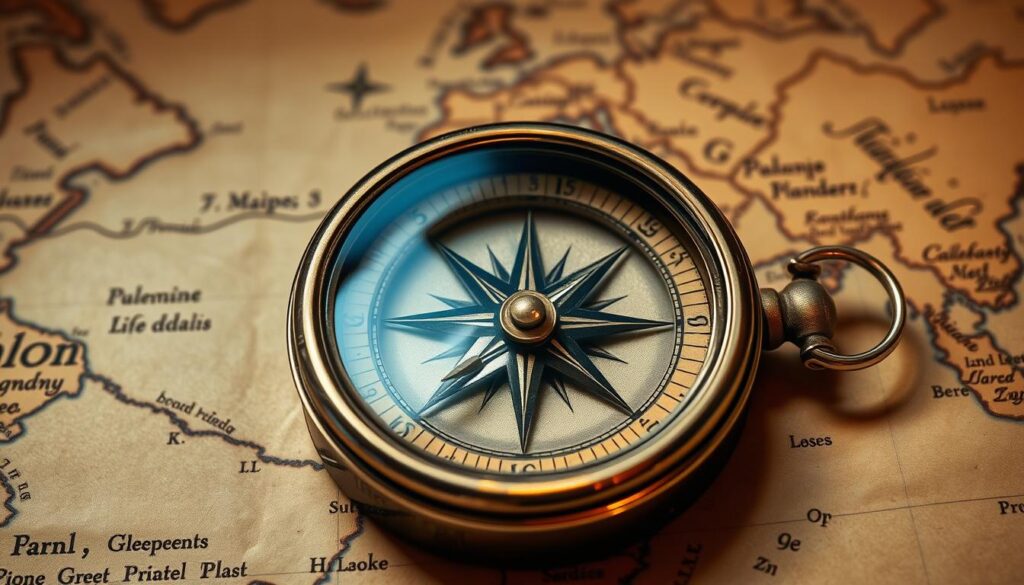Thinking back to my hiking adventures, I remember a time when a safety whistle saved me in a dense forest.
This experience taught me the value of being ready and knowing how to use signaling whistles in emergencies.
If you love the outdoors or want to stay safe, learning the right way to use these whistles is key.
Key Takeaways
- Understand the different types of whistles available for various situations.
- Learn the proper techniques for using a whistle to signal for help.
- Discover how to maintain and care for your safety whistle.
- Know when and how to use your whistle effectively in emergencies.
- Explore additional safety measures to complement your whistle.
What Is a Signaling Whistle?
A signaling whistle is more than just a simple device. It’s a vital piece of safety equipment used in many situations. It helps send messages or alert others over long distances.
Definition and Purpose
A signaling whistle is a device that makes a loud, high-pitched sound when blown. It’s used mainly for signaling or alerting others. These whistles have many uses, like signaling for help or communicating over a distance.
They can also be used as a deterrent against threats. The loud and clear sound they produce is key. This is because they work well when visibility is low or other communication methods fail.
Types of Signaling Whistles
There are many types of signaling whistles, each for different needs and places. Some common ones include:
- Pealess whistles, known for their reliability and not being affected by pea freezing or clogging.
- Plastic whistles, which are lightweight, affordable, and often used in sports and outdoor activities.
- Metal whistles, known for their durability and loud sound, often used in more demanding environments.
When picking a signaling whistle, think about the material, design, and sound frequency. Make sure it fits your specific needs.
Importance of Using a Signaling Whistle
When you go into the wilderness, a signaling whistle is key for safety and talking. It’s simple but very effective for calling for help in emergencies.
Signaling whistles are a must-have for outdoor safety, offering a reliable way to communicate when other methods don’t work. Whether hiking, camping, or doing other outdoor stuff, a signaling whistle can save your life.
Safety and Communication
The main job of a signaling whistle is to keep you safe by letting others know you need help. In emergencies, its loud sound can signal distress and get attention. This is very important when you can’t see well or can’t shout for help.
- Signaling whistles are made to be loud and clear, so they can be heard over other sounds.
- They are a signal that everyone knows, from outdoor fans to rescue teams.
Outdoor Activities
If you love outdoor activities like hiking, camping, or skiing, a signaling whistle is a must-have. It helps in emergencies and gives you peace of mind, knowing you can call for help if needed.
| Outdoor Activity | Importance of Signaling Whistle |
|---|---|
| Hiking | High – In case of injury or getting lost |
| Camping | High – For signaling in case of emergency |
| Skiing | High – When it’s hard to see |
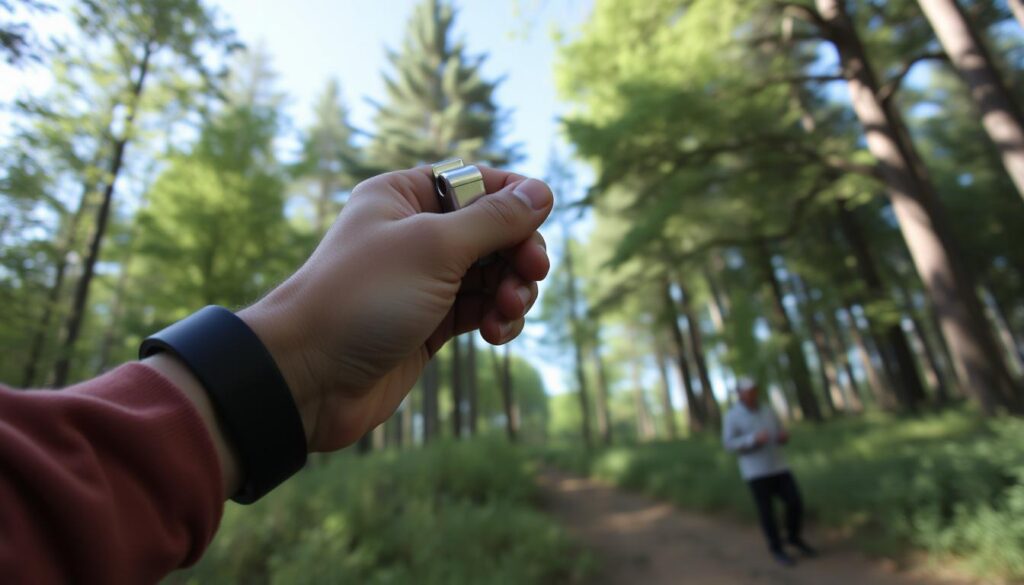
Choosing the Right Signaling Whistle
The right signaling whistle depends on its material, design, and sound frequency. It’s key to think about these when picking a whistle. This ensures it works well for its purpose.
Material and Design
Whistles come in materials like metal, plastic, and composite. The material impacts the whistle’s sturdiness and how it handles weather. For example, metal whistles last longer but can rust if not sealed.
The design of a whistle is also important. A good whistle is simple to use, even with gloves. It should also be comfortable to carry. Some whistles have lanyards or clips for easy attachment.
| Material | Durability | Weather Resistance |
|---|---|---|
| Metal | High | Medium |
| Plastic | Medium | High |
| Composite | High | High |
Sound Frequency Considerations
The sound a whistle makes is very important. Whistles can range from low rumbles to high squeaks. High-pitched sounds are better at getting attention.
But, the sound must be within human hearing range and not hurt your ears. Some whistles are made to produce just the right sound.
How to Use a Signaling Whistle Effectively
I remember the day I learned how vital a signaling whistle is. I got lost on a hike and my signaling whistle saved me. It made a loud, clear sound that everyone heard.
This experience showed me how important it is to use a safety whistle right in emergencies.
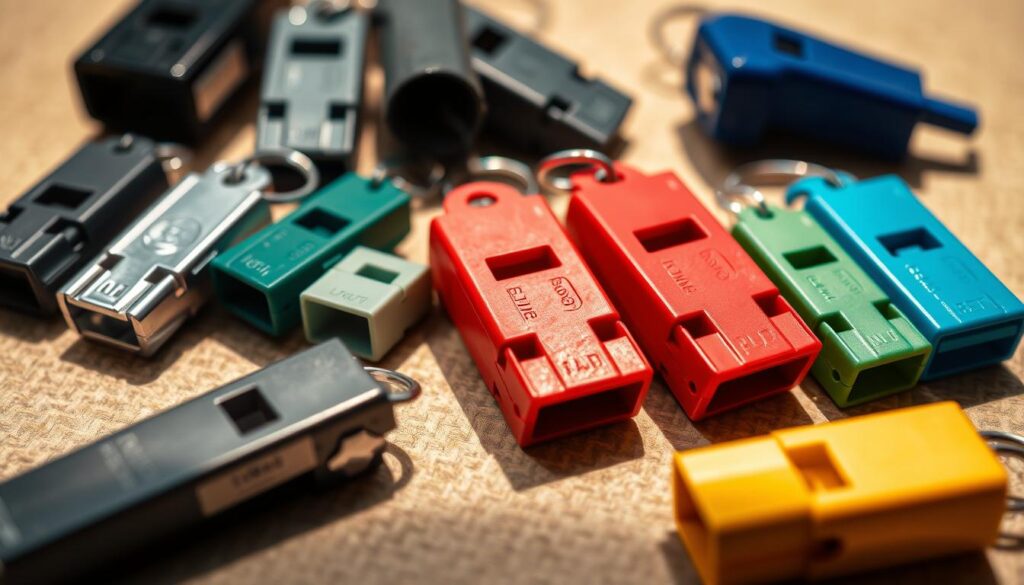
A signaling whistle can really save your life in emergencies. It’s key to know how to use these emergency whistles to stay safe.
Key Takeaways
- Understand the importance of signaling whistles in emergency situations.
- Learn the best practices for using safety whistles effectively.
- Familiarize yourself with safety guidelines for signaling whistle usage.
- Know how to choose the right signaling whistle for your needs.
- Practice using your signaling whistle to ensure you’re prepared.
What Is a Signaling Whistle?
A signaling whistle is a simple tool for communication. It makes a loud, high-pitched sound that can be heard far away. This makes it key for safety and emergencies.
For decades, signaling whistles have been used in sports, at sea, and outdoors. They help signal for help, warn of danger, or communicate over long distances.
Definition and Purpose
The main goal of a signaling whistle is to send a message over distance. Its loud sound can cut through noise, making it a reliable way to communicate. Signaling whistles are made to be simple, strong, and easy to use, even when it matters most.
Types of Signaling Whistles
There are many types of signaling whistles, each with its own features and uses. Pea whistles have a small ball that vibrates to make sound. Pea-less whistles make sound when you blow them. There are also whistles for specific activities, like marine whistles or sports whistles.
Knowing about the different types of signaling whistles and their uses is important. The right whistle can be a game-changer in safety, communication, or signaling situations.
Importance of Using a Signaling Whistle
Going into the wilderness or doing outdoor activities? A signaling whistle can save your life. I remember a time when a friend got lost in the woods. He used a whistle to call for help. It’s clear, a signaling whistle is key for staying safe and communicating in emergencies.
Using a signaling whistle is vital for safety and communication in activities like hiking, camping, or boating. It’s a simple way to call for help in emergencies. For example, in fog or at night, a whistle can be heard much farther than a shout.
Safety and Communication
A signaling whistle is a must-have for safety and talking to others. It lets you signal you’re there, call for help, or warn of dangers. Unlike shouting or other sounds, a whistle can be heard from far away and is less likely to be drowned out.
For instance, on a hiking trip, a whistle can alert other hikers or authorities in an emergency. Its loud, high-pitched sound can travel a long way, making it a great way to communicate in the wild.
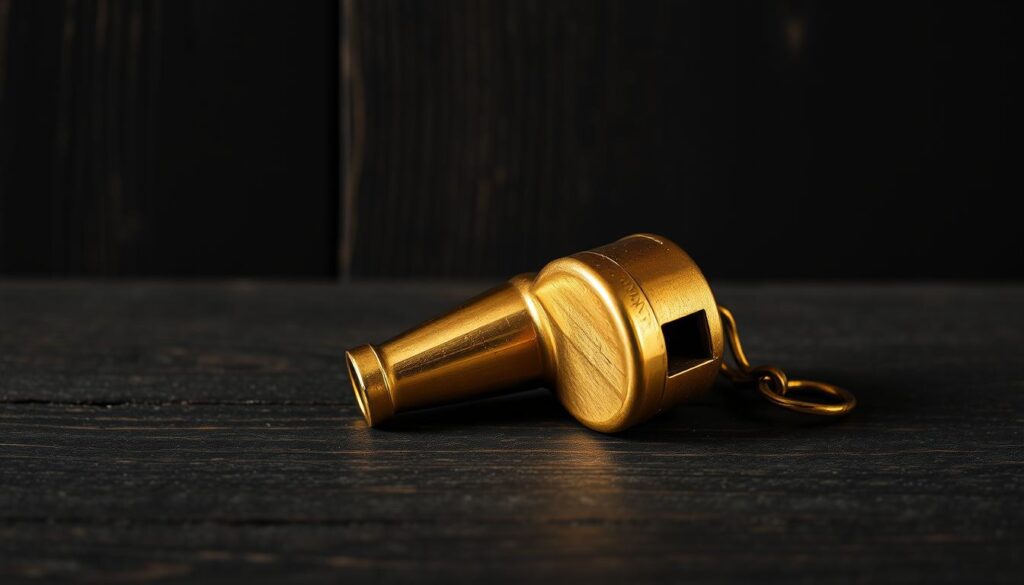
Outdoor Activities
Activities like hiking, camping, or boating often happen where phones don’t work well. In these places, a signaling whistle is a lifesaver. It ensures you can call for help if needed.
| Activity | Signaling Whistle Use |
|---|---|
| Hiking | Signal for help, alert others to presence |
| Camping | Signal for help, alert others to presence |
| Boating | Signal for help, alert others to presence in case of emergency |
Choosing the Right Signaling Whistle
When picking a signaling whistle, several key factors are important. These include the material, design, and sound frequency. Each of these elements plays a big role in how well the whistle works.
Signaling whistles come in different materials like metal, plastic, and composite materials. The material affects how long the whistle lasts and how well it handles the weather. For example, pea-less whistles made from metal or tough plastic are great for harsh weather. It’s important to think about where you’ll use the whistle.
Material and Design
The design of a signaling whistle is also key. A good whistle is easy to use, even when you’re wearing gloves or in a hurry. Some whistles have a lanyard or clip for attaching to your clothes or gear. This makes them more useful in emergency situations. Plus, a whistle that fits well in your hand is easier to use.
| Material | Durability | Weather Resistance |
|---|---|---|
| Metal | High | High |
| Plastic | Medium | Medium |
| Composite | High | High |
Sound Frequency Considerations
The sound a whistle makes is very important. Whistles make sounds in a certain range, with some being high-pitched and louder. This makes them easier to hear from far away. Studies say a whistle that makes a sound between 2,000 to 4,000 Hz is best for signaling. It’s loud but not too loud, and can cut through other sounds.
“A good signaling whistle should be loud, clear, and easy to use, making it an indispensable tool for outdoor enthusiasts and professionals alike.”
In summary, picking the right signaling whistle means looking at its material, design, and sound. By focusing on these, you can find a whistle that works well and is reliable when you need it most.
How to Signal Effectively Using a Whistle
Using a whistle to signal means knowing the difference between short and long blasts. It’s key to send your message clearly and avoid mistakes. You need to make sounds that are easy to understand.
Short and Long Blasts
Short blasts are for getting someone’s attention or sending a simple message. Long blasts are for emergencies or danger. Knowing the difference is vital for clear communication.
In outdoor activities, short blasts can say you’re there. A long blast means you need help.
Patterns for Attention
Using patterns with your whistle can grab attention better. For example, three short blasts are a universal distress signal. Specific patterns help send different messages and ensure they’re understood.
Be consistent with your patterns to avoid confusion. Mixing short and long blasts in a pattern makes your signal unique and easy to recognize.
Situations to Use a Signaling Whistle
Knowing when to use a signaling whistle can save lives. It’s vital for outdoor lovers and those facing emergencies. Understanding when and how to use it is key.
Outdoor Adventures
For those exploring the wilderness or enjoying activities like hiking and skiing, a signaling whistle is essential. It’s a simple way to call for help in emergencies. For example, if you get lost or hurt while hiking, a whistle can signal your location.
- Use short, three-blast sequences to signal for help.
- Always carry your signaling whistle during outdoor adventures.
Emergency Scenarios
In emergencies like natural disasters or accidents, a signaling whistle is a lifesaver. It helps you signal your location to rescuers or alert others to your distress.
Examples of emergency scenarios include:
- Being lost in the woods without a means of communication.
- Experiencing a medical emergency while outdoors.
- Surviving a natural disaster like an earthquake or hurricane.
Using a signaling whistle wisely in these situations can greatly improve your chances of rescue.
Maintenance and Care of My Signaling Whistle
Keeping my signaling whistle in top shape is a must. Regular care extends its life and keeps it working right when I need it.
Cleaning and Inspection
Cleaning my whistle regularly is key. It gets rid of dirt and keeps the sound clear. I rinse it with water and use a soft brush for tough spots.
After cleaning, I check for wear or damage. I look for cracks or corrosion that could mess up its sound.
Checking the pea is important too. It should move freely without getting stuck. I also make sure the mouthpiece is clear and the pea chamber is free of blockages.
Storage Tips
Storing my whistle right is just as important. I keep it in a dry spot, out of the sun. Extreme temperatures can harm the material.
Using a protective case or pouch helps prevent damage. These steps keep my whistle ready for action.
Legal Considerations for Signaling Whistles
It’s important to know the laws about signaling whistles for their proper use. This is true, mainly when looking at local regulations. The rules around signaling whistles are complex and varied.
Local Regulations
Every area has its own rules for using signaling whistles. For example, some places might only allow certain types of whistles. In the U.S., laws about whistles can change a lot from state to state.
The Code of Federal Regulations has rules for using signaling devices, like whistles, in places like the sea and sky.
Use in Public Spaces
Using signaling whistles in public spaces also has legal rules. Places like parks might have special rules for using these devices. For instance, in some spots, you can only use them in emergencies or for certain events.
Knowing these rules is key to using signaling whistles right. By understanding local regulations and where to use them, people can stay within the law.
Enhancing Visibility While Signaling
Visibility is key when you’re signaling for help. Being easy to see makes your signals more effective. It helps others find you quickly.
Clothing and Gear Tips
Choosing the right clothes and gear can boost your visibility. Wear brightly colored clothing that contrasts with your surroundings. Also, use reflective materials or gear with reflective strips for better visibility in the dark.
For outdoor fun, pick clothes with built-in reflectors or add reflective accessories. Think about reflective vests or arm bands that catch light.
Using Accessories
Accessories can also help you stand out. Attach flashlights or LED lights to your whistle or clothes. This makes you visible from far away.
Using signal mirrors or reflective flags is another smart move. They reflect sunlight towards rescuers during the day. This makes your signal more visible.
Troubleshooting Common Issues with Whistles
To keep your signaling whistle working well, it’s key to spot and fix problems fast. Whistles are vital for safety and talking in the outdoors or emergencies.
Sound Problems
Sound issues are a big problem with signaling whistles. If your whistle doesn’t sound clear or loud, there are a few things to check.
- Blockages: Dirt, debris, or moisture can block the sound. Cleaning it often can stop this.
- Material Degradation: The whistle’s material can wear out over time. Check it often to catch problems early.
For instance, a pea whistle might not work if the pea gets stuck. Make sure all parts are in good shape.
Physical Damage
Physical damage is another big problem. It can be from small scratches to big cracks or breaks.
| Type of Damage | Cause | Solution |
|---|---|---|
| Minor Scratches | Normal wear and tear | Inspect regularly; may not affect functionality |
| Cracks or Breaks | Impact or excessive force | Replace the whistle |
| Corrosion | Exposure to moisture or chemicals | Clean or replace depending on severity |
Checking your whistle often can catch these problems early. If you see damage, fix it fast to keep your whistle working.
Conclusion: My Take on Using Signaling Whistles
Using signaling whistles well takes practice and knowing their importance. They are key for safety and talking in the outdoors and emergencies.
Effective Signaling Techniques
To signal well, learn the different ways to use whistles. This includes short and long sounds and patterns to get attention. Knowing these helps send messages clearly and fast.
Practicing with Signaling Whistles
It’s important to practice with signaling whistles to get good at them. Regular practice builds muscle memory and makes sure you use the whistle right when it matters most. I suggest practicing to get better and feel more ready.
Adding signaling whistles to your daily routine makes you more aware and ready. They can save lives in emergencies. With regular practice, you’ll get better and more confident. This boosts your safety and well-being.
FAQ
What is the most effective way to use a signaling whistle in an emergency situation?
To signal for help, use three short blasts, then a pause, and repeat. This is a universal signal that helps rescuers find you fast.
How do I choose the right signaling whistle for outdoor activities like hiking or camping?
Look for a whistle made from durable materials like pea-less plastic or stainless steel. It should produce a loud, high-pitched sound that carries far.
Can I use a signaling whistle in all types of weather conditions?
Yes, you can use a signaling whistle in rain, snow, and extreme temperatures. Just make sure it’s designed to withstand these conditions.
How do I maintain and care for my signaling whistle?
Clean your whistle with soap and water, check for damage, and store it dry. This keeps it ready for emergencies.
Are there any local regulations or restrictions on using signaling whistles in public spaces?
Yes, check local rules before using a whistle in public. Some places have noise limits or restrictions on whistle use.
Can I use a signaling whistle in conjunction with other safety gear, like flares or mirrors?
Yes, you can use a whistle with other safety gear like flares, mirrors, or bright clothes. This makes you more visible and effective in emergencies.
How can I troubleshoot common issues with my signaling whistle, such as a weak or distorted sound?
For a weak or distorted sound, check for blockages, clean the whistle, or look for damage. Make sure you’re using it right, as wrong use can lower its performance.

